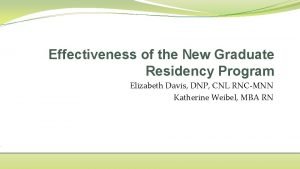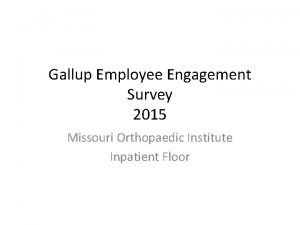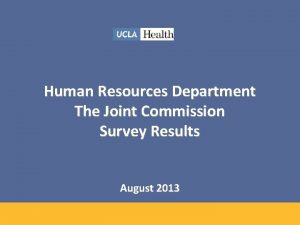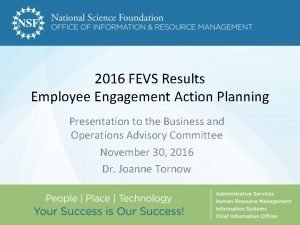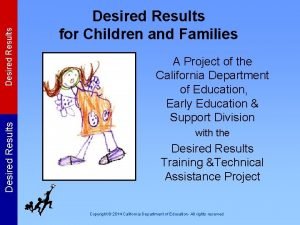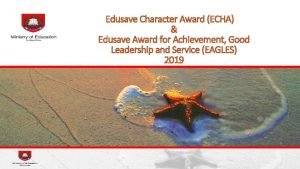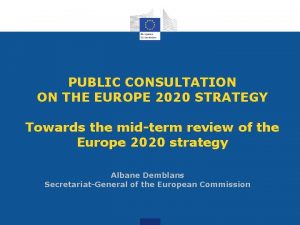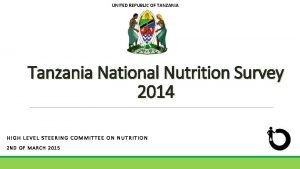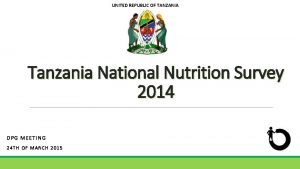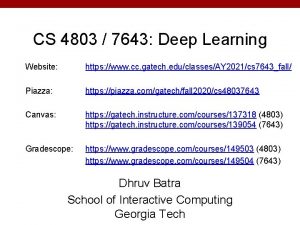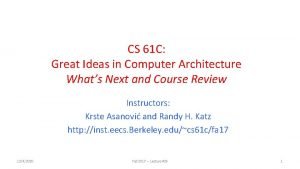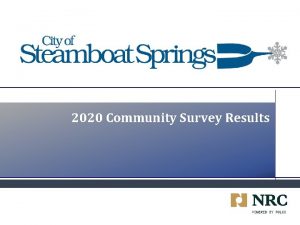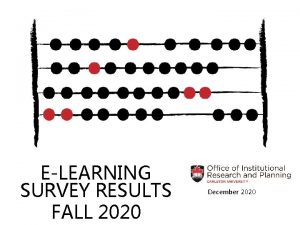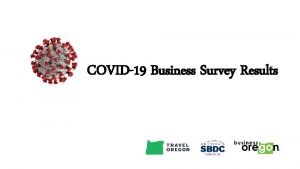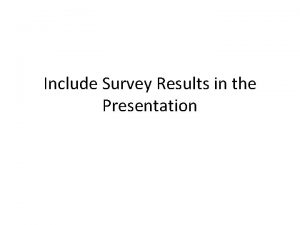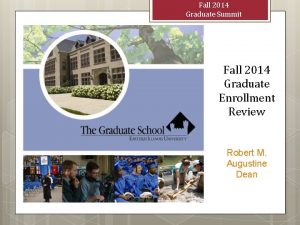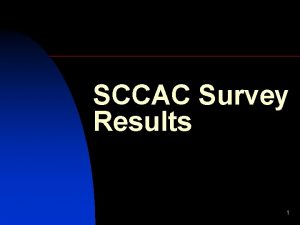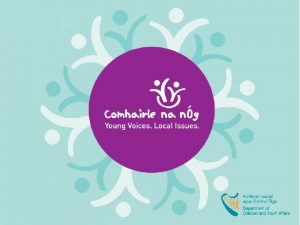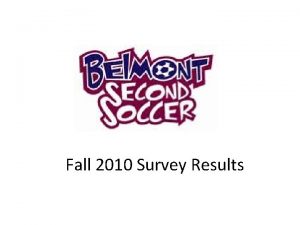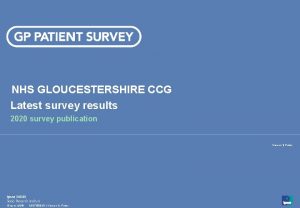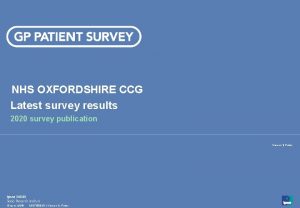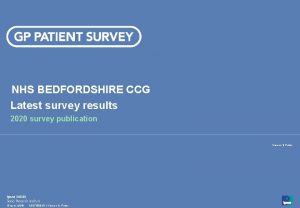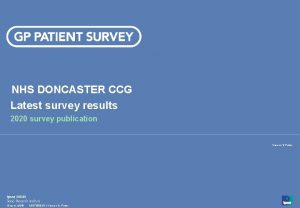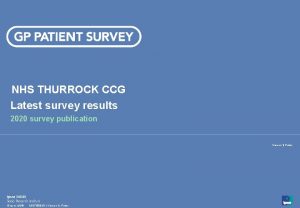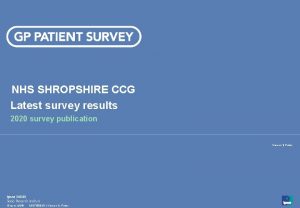Fall 2020 Graduate Experience Survey Results Graduate School


















- Slides: 18

Fall 2020 Graduate Experience Survey Results Graduate School University of Wisconsin, Madison Contact: parmesh. ramanathan@wisc. edu

Survey Summary • Survey administered to 5423 doctoral students and 3850 Masters students (Oct 27, 2020 – Nov 16, 2020) • Response rate as Nov 11, 2020: 2735 (29. 49%) § 1521 Doctoral Students (28. 04%) § 1179 Masters Students (30. 62%) • 73. 4% of the respondents said that they reside in United States • 4. 78% of the respondents said that they reside outside the United States § 93. 83% of those in US reside within commuting distance of Madison • 42% of respondents are Male and 58% are Female • 70 % US Citizens, 30 % Not US Citizens 2

Major Takeaways: Academic Progress • In the current environment, top challenges for graduate students in making academic progress are § § § No or limited access to field experience Limited in-person interaction with fellow students No or limited ability to collected face-to-face research data Limited networking opportunities Limited access to research office space • On the positive side, § access to required courses § access to course technology, and § access to needed software, computing, and storage resources are not reported as major barriers to making academic progress 3

Major Takeaways: Teaching Experience For graduate students involved in teaching, • dealing with teaching technology and • ability to provide synchronous, and one-onone interaction to their students are reported to be the biggest challenge. On the positive side, even among students involved in teaching in-person sections, only a small fraction of TAs report challenges with • classroom facilities • teaching spaces, and • access to personal protection equipment. 4

Q 6: Comfort coming to campus • Currently, how comfortable are you coming to campus for inperson activities? § § For class For research For work For social interaction • Responses on 5 -point Likert scale § § § Not at all (comfortable) A little (comfortable) Somewhat (comfortable) Very (comfortable) Extremely (comfortable) 5

Comfortable Coming to Campus for In-person Activities (Doctoral Stu) 6

Comfortable Coming to Campus for In-person Activities (Masters Stu) 7

Comfortable coming to campus for in-person activities Remarks • At least 40% of the respondents are not comfortable coming to campus for in-person activities. • Respondents are more comfortable coming to campus for research as compared to class, work, or social interaction • Not much difference in the responses between doctoral and Master’s students. 8

Q 7, Q 8: Challenges/Barriers to Academic Progress • Q 7: Currently, how much are the following factors affecting your academic progress? • Q 8: Currently, how much are the following factors a barrier to your academic progress? § 23 different factors • Responses on 5 -point Likert scale § § § Not at all (barrier) A little (barrier) Somewhat (barrier) Quite a bit (barrier) A great deal (barrier) 9

Challenges/Barriers to academic progress (Doctoral Students) 10

Challenges/Barriers to academic progress (Masters Students) 11

Challenges/Barriers to academic progress (Doctoral Students) Remarks • For at least 25% of doctoral respondents the following factors were quite a bit or a great deal of challenge to academic progress § Limited interaction with fellow students § Access to field experience § Ability to collect f 2 f data § Limited networking opportunities § Access to office § Mental health § Access to research lab Remarks • For at least 75% of doctoral respondents the following factors were not a or a little challenge to academic progress § § Physical health Access to course Transportation to campus Financial challenges caused by COVID-19 § Difficult paying rent/mortgage § Access to studio § Difficulty putting food on the table 12

Challenges/Barriers to academic progress (Masters Students) Remarks • For at least 25% of Masters respondents the following factors were quite a bit or a great deal of challenge to academic progress § Access to library § Limited networking opportunities § Ability to collect f 2 f data § Limited in-person interaction with fellow students § Access to field experience Remarks • For at least 75% of doctoral respondents the following factors were not a or a little challenge to academic progress § Financial challenges caused by COVID-19 § Restrictions on travel § Physical health § Access to studio § Difficulty paying rent/mortgage § Transportation to campus § Difficulty putting food on table 13

Challenges to teaching a course as a teaching assistant • In teaching the course, how much are the following factors a challenge? § 10 factors • Responses on 5 -point Likert scale § § § Not at all (challenge) A little (challenge) Somewhat (challenge) Quite a bit (challenge) A great deal (challenge) 14

Challenges to teaching (TA) Remote Sections 15

Challenges to teaching (TA) In-person Sections 16

Challenges to teaching course (Remote sections) Remarks • For at least 25% of remote section TA respondents the following factors were quite a bit or a great deal of challenge to academic progress § Teaching technology § Asynchronous interaction with students § Synchronous interaction with students § One-on-one interaction with students Remarks • For at least 75% of remote section respondents the following factors were not a or a little challenge to academic progress § § § PPE Classroom facilities Classroom space Lab space Studio space 17

Challenges to teaching course (Inperson sections) Remarks • For at least 25% of remote section TA respondents the following factors were quite a bit or a great deal of challenge to academic progress § Teaching technology § Synchronous interaction with students § One-on-one interaction with students Remarks • For at least 75% of inperson section respondents the following factors were not a or a little challenge to academic progress § Lab space § Studio space 18
 Casey fink graduate nurse experience survey
Casey fink graduate nurse experience survey Imprinting psychology
Imprinting psychology Early experience vs. later experience
Early experience vs. later experience Direct and indirect experience examples
Direct and indirect experience examples Gallup survey employee engagement 2015
Gallup survey employee engagement 2015 Joint commission survey results
Joint commission survey results Employee engagement survey action plan ppt
Employee engagement survey action plan ppt Desired results parent survey
Desired results parent survey Experience survey in exploratory research
Experience survey in exploratory research Primary abcd
Primary abcd Echa awards
Echa awards Europe 2020 strategy results
Europe 2020 strategy results Ucat anz dates
Ucat anz dates Tanzania national nutrition survey 2020
Tanzania national nutrition survey 2020 Tanzania national nutrition survey 2018
Tanzania national nutrition survey 2018 European working conditions survey 2020
European working conditions survey 2020 Cs 7643 fall 2020
Cs 7643 fall 2020 Cs61c fall 2020
Cs61c fall 2020 Cs61c fall 2020
Cs61c fall 2020
